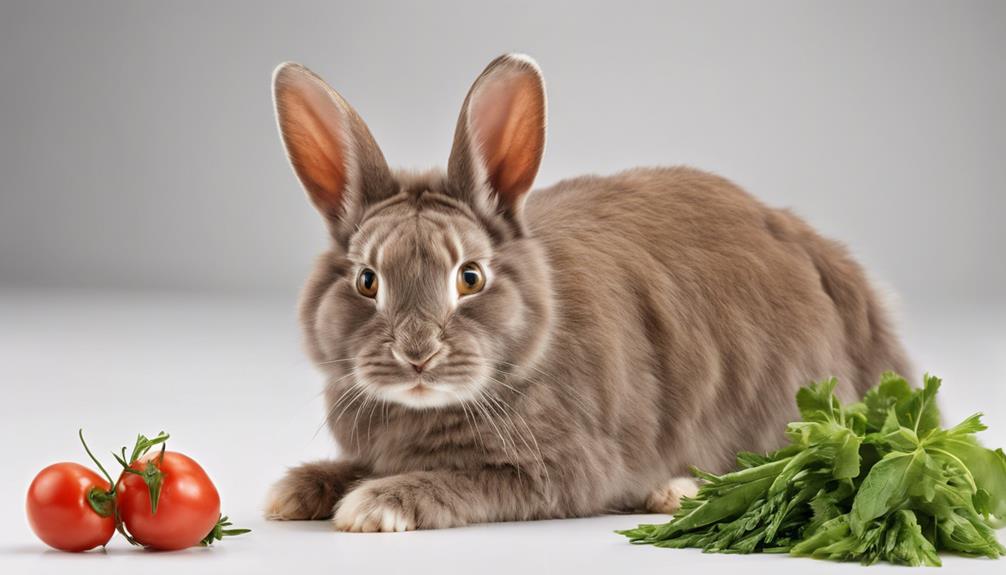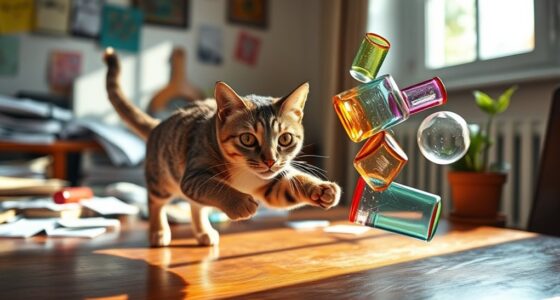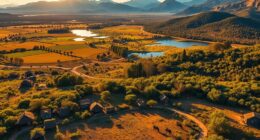When it comes to dealing with cat chin mites, it is important to use effective treatments. Options like selamectin, lime sulfur dips, or ivermectin are aimed at getting rid of mites and alleviating symptoms such as itching, redness, and hair loss. Topical solutions like fipronil or medicated shampoos are specifically designed to target and eliminate mites in the affected chin area. To prevent future occurrences, it is essential to maintain regular chin hygiene, address underlying causes, and seek advice from a veterinary professional. For relief, it is recommended to consistently apply prescribed treatments, handle your cat with care, and follow up with your vet as needed. Prioritizing your cat’s comfort by providing soft bedding and a peaceful environment can help with the recovery process. Stay informed for more helpful tips and strategies.
Key Takeaways
- Selamectin, ivermectin, lime sulfur dips, or insecticides are effective treatments.
- Topical solutions like fipronil and medicated shampoos target and eliminate mites.
- Treatments aim to relieve itching, redness, hair loss, and skin inflammation.
- Consult a veterinarian for proper diagnosis and tailored treatment plans.
- Regular chin hygiene, grooming, and monitoring aid in long-term prevention and well-being.
Understanding Cat Chin Mites
When dealing with cat chin mites, understanding the nature of these parasitic invaders is vital for effective treatment. These tiny mites, such as Demodex, Otodectes, Cheyletiella, Notoedres, and Sarcoptes, target the delicate skin of a cat's chin, causing discomfort and irritation. Diagnosis of cat chin mites typically involves a close examination of the skin through skin scrapings or microscopic evaluation to confirm the presence of these pesky parasites.
Once the diagnosis is established, appropriate treatment measures can be initiated to combat these mites effectively. Treatment options for cat chin mites may include medications like selamectin, ivermectin, lime sulfur dips, or other insecticides prescribed by a veterinarian. These treatments are aimed at eliminating the mites from the cat's skin and providing relief from the associated symptoms like itching, redness, and hair loss.
Understanding the behavior and characteristics of these mites is essential in addressing the issue promptly and preventing further discomfort for our feline companions.
Symptoms of Cat Chin Mites

To identify cat chin mites, pay attention to symptoms like itching, redness, and inflammation in the chin area. When dealing with cat chin mites, it's important to be mindful of the following signs:
- Itching: Cats with chin mites may experience intense itching in the chin region, leading them to scratch frequently.
- Redness: The affected area on the chin may appear red and irritated due to the presence of mites.
- Inflammation: Swelling and discomfort are common symptoms of cat chin mites, causing inflammation for the feline friend.
If you observe your cat showing these signs, it's vital to take prompt action to address the issue effectively. Look out for additional indicators such as hair loss, scabs, or crusts, as these could also indicate a cat chin mite infestation. Early detection plays a crucial role in managing symptoms and preventing further skin complications in cats affected by chin mites.
Causes of Cat Chin Mites

Cat chin mites are mainly caused by Demodex mites, small parasites that reside in the hair follicles and sebaceous glands on the chin. These mites can result in various skin issues such as irritation, infection, redness, and even open sores on the affected area.
Understanding the origins of cat chin mites is essential in recognizing the symptoms of infestation and exploring the treatment options available.
Cat Chin Mites Origins
Originating from tiny Demodex mites residing in the hair follicles and sebaceous glands of cats, cat chin mites commonly trigger various skin issues. These mites can lead to skin irritation, infections, hair loss, redness, inflammation, scabs, crusts, and open sores. Understanding the root cause of cat chin mites is essential in addressing the condition effectively.
Here are some key points to keep in mind:
- Demodex mites infest cat chins, causing skin problems.
- The presence of these mites can result in a range of skin irritations.
- Proper diagnosis and treatment are vital to managing cat chin mites and alleviating associated skin issues effectively.
Symptoms of Infestation
Symptoms of cat chin mite infestation typically manifest as itching, redness, hair loss, scabs, and inflammation in the chin area. Cats afflicted by these mites may exhibit visible signs such as hair loss, crusting, red bumps, and open sores on their chin.
These skin problems can be worrisome for our feline friends, causing discomfort and irritation. It's important to pay attention to these symptoms as they can indicate a deeper issue like cat chin mites. Identifying these signs early on allows for prompt treatment, preventing further skin complications.
Treatment Options Available
When addressing cat chin mites, understanding the available treatment options is essential for effectively combating the infestation and restoring the affected feline's skin health.
Treatment options include:
- Medication: Your vet may prescribe topical or oral medications to kill the mites and alleviate skin irritation.
- Antibiotics: In cases where secondary infections occur due to cat chin mites, antibiotics might be necessary to treat the infection.
- Topical Treatments: Specialized ointments or shampoos can help soothe the affected area and promote healing of any skin lesions caused by the mites.
Diagnosis of Cat Chin Mites

To diagnose cat chin mites accurately, veterinarians typically perform skin scraping to identify the presence of mites in the hair follicles and sebaceous glands. This process involves collecting a small sample of skin cells from the affected area to examine under a microscope.
A critical examination by the veterinarian is necessary for spotting the characteristic signs of chin mites, such as redness, crusting, or hair loss. By conducting a trichogram, veterinarians can further inspect the mites closely and confirm the diagnosis.
Demodex mites, which cause skin irritation and infection, can be detected through microscopic evaluation of skin samples. It's essential for veterinarians to differentiate between cat chin mites and other skin conditions like chin acne to provide the appropriate treatment.
Through these diagnostic methods, veterinarians can accurately identify cat chin mites and devise a targeted treatment plan to alleviate discomfort and promote healing.
Topical Treatments for Cat Chin Mites
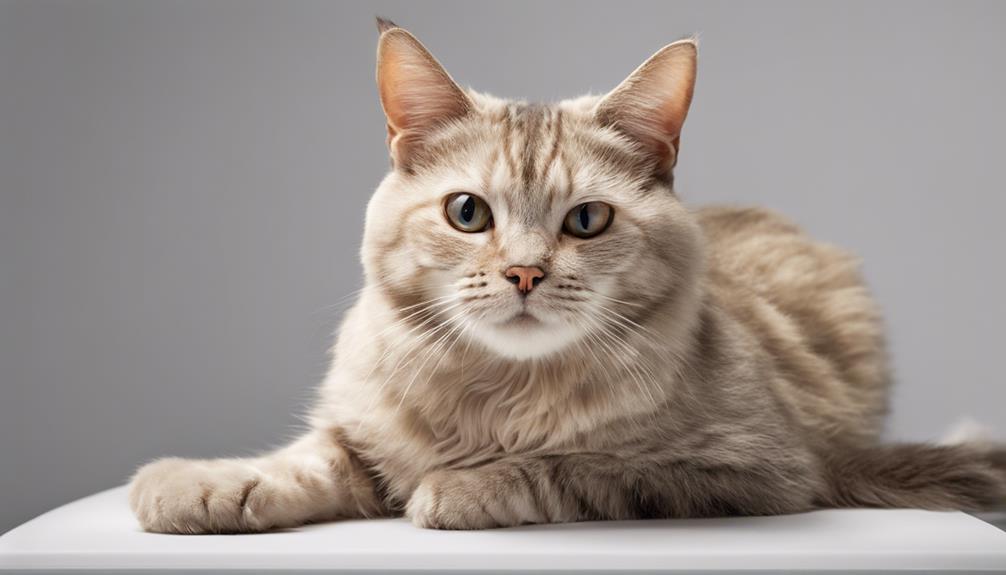
When managing cat chin mites, applying topical treatments is an important step in effectively targeting and eliminating the mites causing irritation and skin issues. These treatments are specifically designed to combat the pesky mites on your cat's chin area. Some topical solutions contain potent ingredients like selamectin or fipronil, known for their efficacy in eradicating mites effectively.
Here are three key points to contemplate regarding topical treatments for cat chin mites:
- Medicated shampoos or ointments: These products are formulated to kill mites on the chin area, providing direct relief to your cat.
- Selamectin and fipronil: These components are highly effective against mites and are commonly found in topical treatments recommended by veterinarians.
- Targeted application: Applying the treatment directly to the affected chin area helps in targeting and eliminating the mites responsible for the skin issues, promoting healing and restoring skin health in your cat.
Importance of Proper Hygiene

Maintaining proper hygiene practices is essential for preventing and managing cat chin mites infestations. Cats are susceptible to chin mites, which can cause discomfort and irritation if not addressed promptly. Regular cleaning of your cat's chin area is vital in reducing the risk of mite infestations.
By using vet-recommended cleaning solutions and products, you can effectively control and manage these pesky parasites. Additionally, making sure that your cat's living environment is clean and free from other parasites can support the effectiveness of mite treatments.
Good hygiene practices play a significant role in the faster recovery and long-term management of cat chin mites. Remember, a clean chin and environment can go a long way in keeping your feline friend healthy and happy. So, let's prioritize hygiene to keep those chin mites at bay and guarantee our cats are comfortable and thriving.
Stress Management for Cats

Implementing stress management strategies is essential for enhancing the well-being of cats and alleviating skin conditions such as chin mites. Cats, like us, can experience anxiety and stress, impacting their overall health. Here are some effective ways to help your feline friend relax and thrive:
- Create an Enriched Environment: Providing interactive toys, scratching posts, and safe hiding spots can offer mental stimulation and reduce stress levels.
- Engage in Regular Playtime: Spending quality time playing with your cat not only strengthens your bond but also promotes relaxation and reduces anxiety.
- Establish a Consistent Routine: Cats thrive on predictability, so maintaining a regular schedule for feeding, play, and rest can help lower their stress levels.
Monitoring Cat Chin Mites

When monitoring cat chin mites, it's important to watch out for symptoms like:
- itching,
- redness,
- hair loss, and
- skin inflammation on the chin area.
Changes in behavior, such as increased scratching or discomfort around the chin, can also be telltale signs of mites.
Symptoms of Chin Mites
Symptoms of chin mites in cats manifest as:
- Redness
- Itching
- Hair loss
- Scabs
- Crusts on the chin area
Additional signs include:
- Excessive scratching or rubbing of the chin and face
These symptoms indicate a potential infestation that requires prompt attention. When monitoring your cat for chin mites, keep an eye out for:
- Red bumps or patches on the chin area
- Persistent itching and scratching
- Hair loss or thinning in the chin region
Treatment Options Available
After identifying symptoms of chin mites in cats, the next step involves exploring available treatment options for effectively managing and eradicating the mites. Monitoring cat chin mites includes regular skin examinations to check for mites, skin irritation, hair loss, and other symptoms. Treatment options for cat chin mites may include topical medications prescribed by a veterinarian to kill the mites effectively. It is important to follow the prescribed treatment regimen and monitor the cat's progress to guarantee the mites are eradicated. In severe cases, additional treatments such as anti-inflammatory drugs or antibiotics may be necessary to manage the mite infestation effectively. Regular follow-up appointments with the vet are recommended to assess the cat's response to treatment and make any necessary adjustments for best results.
| Treatment Options | Description |
|---|---|
| Topical Medications | Prescribed by a vet to eliminate mites effectively |
| Severe Cases | Additional treatments like anti-inflammatory drugs |
Long-Term Well-Being Strategies

How can we guarantee the long-term well-being of cats affected by chin mites?
When it comes to ensuring the ongoing health and happiness of our feline friends dealing with chin mites, there are some key strategies to keep in mind:
- Regular Chin Hygiene Routines: Implementing consistent chin hygiene practices is important in preventing the recurrence of cat chin mites. Regularly cleaning and monitoring your cat's chin area can help in detecting any early signs of mites and addressing them promptly.
- Address Underlying Causes: Apart from using prescribed topical medications, it's crucial to address any underlying issues that may be contributing to the mite infestation. Factors like stress or allergic reactions can exacerbate the condition, so identifying and managing these root causes is essential for the long-term well-being of your cat.
- Consult a Veterinarian for Long-Term Management: Seeking professional guidance and advice from a veterinarian is important for developing effective long-term management strategies for cat chin mites. Veterinarians can provide tailored recommendations and monitor your cat's progress to ensure their overall health and well-being.
Veterinarian-Prescribed Medications

When treating cat chin mites, veterinarians may prescribe medications like selamectin or ivermectin to effectively target and eliminate the infestation.
These medications can be applied topically or administered orally, depending on the severity of the condition and the cat's health status.
It's important to follow the veterinarian's instructions regarding the type of medication, application techniques, and treatment duration to secure the best outcome for your feline friend.
Medication Types
What prescription medications are commonly used by veterinarians to treat cat chin mites?
- Topical treatments like selamectin
- Fipronil
- Imidacloprid/moxidectin
These medications target the mites residing on the skin and work towards eliminating the infestation. Veterinarian-prescribed medications play an important role in effectively treating cat chin mites and managing any associated skin issues.
Depending on the severity of the infestation, your vet may recommend a specific medication or a combination therapy for the best results. Remember, consistent application of the prescribed medication as instructed by the veterinarian is key to successfully eradicating cat chin mites. Trust your vet's guidance and follow the treatment plan diligently for the health and comfort of your feline companion.
Application Instructions
Moving from discussing prescription medications commonly used for cat chin mites, applying these treatments correctly is vital for effective eradication and management of the infestation. Follow the veterinarian's instructions meticulously to guarantee ideal results.
When applying the prescribed medication, make sure to target the affected area on your cat's chin precisely as directed. Complete coverage of the chin area is essential to effectively combat the mites.
Keep a close eye on your cat for any signs of improvement or adverse reactions to the treatment. If you notice any concerns or unexpected reactions during the treatment process, contact your veterinarian right away for guidance.
Proper application of the medication is key to successfully treating cat chin mites.
Treatment Duration
The treatment duration for veterinarian-prescribed medications for cat chin mites typically varies depending on the severity of the infestation and the cat's response to the prescribed treatment plan.
- Treatment may range from several weeks to a few months, tailored to your cat's specific needs.
- Regular follow-up appointments with the vet are essential to track progress and make any necessary adjustments.
- Some medications might require multiple administrations throughout the treatment period for best effectiveness.
Ensuring your furry companion completes the full treatment duration is vital to completely eradicate the mites and prevent any chances of a recurrence. Trusting the vet's guidance and staying committed to the treatment plan will help your cat get back to their playful self in no time!
Alleviating Skin Issues

To alleviate skin issues in cats affected by mite infestations, it's essential to administer appropriate topical medications recommended by veterinarians. When dealing with cat chin mites or other mite infestations causing skin problems, treatments like selamectin and fipronil have shown effectiveness in addressing these issues. These medications work to target the mites or their eggs directly, helping to alleviate symptoms such as itching, redness, scales, and hair loss. By following the guidance of your veterinarian and applying these topical treatments as directed, you can support your cat in finding relief from the discomfort caused by mites.
In addition to topical medications, it's important to create a soothing environment for your cat during this time. Providing a calm and stress-free space can aid in their recovery process. Remember to handle your cat gently and with care, ensuring they feel safe and secure throughout their treatment for skin issues related to mite infestations. By combining proper medication with a supportive environment, you can help your feline companion feel more comfortable as they work towards healing their skin.
Relief From Itching and Redness
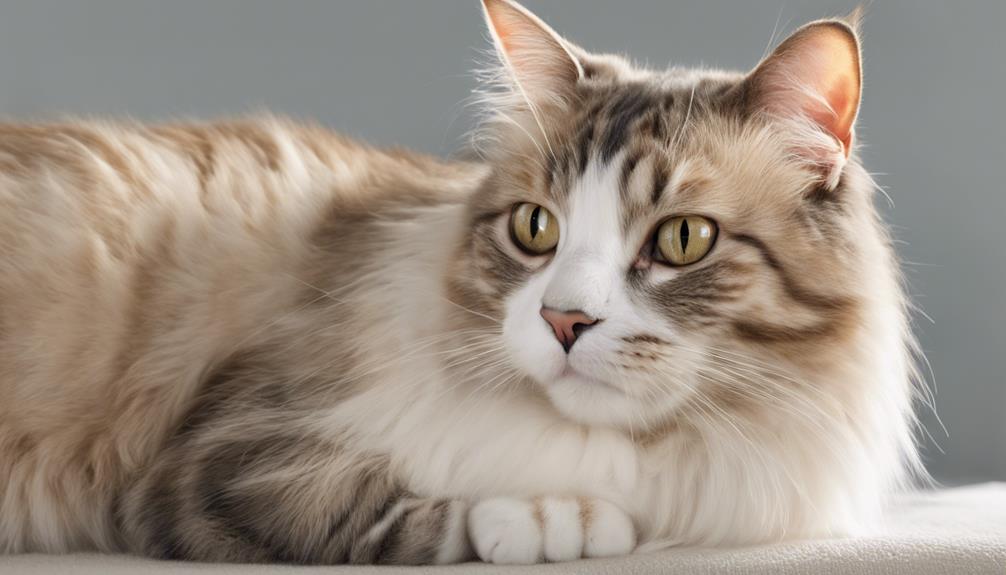
When addressing cat chin mites and their associated itching and redness, utilizing topical treatments like fipronil, selamectin, or imidacloprid/moxidectin is essential for providing relief. These medications target the mites infesting the skin, helping to alleviate discomfort and inflammation. Regular application as prescribed by a veterinarian is vital for effectively managing cat chin mites and reducing symptoms. In severe cases, additional treatments like corticosteroids may be necessary to address intense itching and skin irritation.
- Consistent Application: Applying the topical treatments regularly as directed by your vet ensures optimal effectiveness in combating cat chin mites and their symptoms.
- Follow-up Care: Regular check-ups with the veterinarian can help monitor the progress of the treatment and make any necessary adjustments to guarantee your cat's comfort.
- Gentle Care: Providing gentle care and attention to your cat's affected chin area can aid in soothing the itching and redness while the treatments take effect.
Hair Loss Prevention

Regular grooming and cleaning of the cat's chin area can greatly aid in preventing hair loss caused by chin mites. By gently removing any debris or crust that may harbor mites, we can help maintain healthy hair follicles and prevent unnecessary shedding. Additionally, using vet-recommended topical medications can effectively target chin mites and reduce the risk of hair loss. These medications can soothe irritated skin, promote healing, and ultimately preserve your feline friend's lush coat.
It's important to note that cat acne, often mistaken for chin mites, can also contribute to hair loss if left untreated. Ensuring your cat's chin area is clean and free from excess oil buildup can help prevent acne flare-ups and subsequent hair loss. By incorporating these simple practices into your cat's grooming routine, you can proactively protect their hair from the damaging effects of chin mites and other skin conditions. Remember, a healthy diet and stress-free environment further support your cat's overall well-being and can aid in maintaining a vibrant coat free from the effects of chin mites.
Cat Chin Mites Prevention Tips
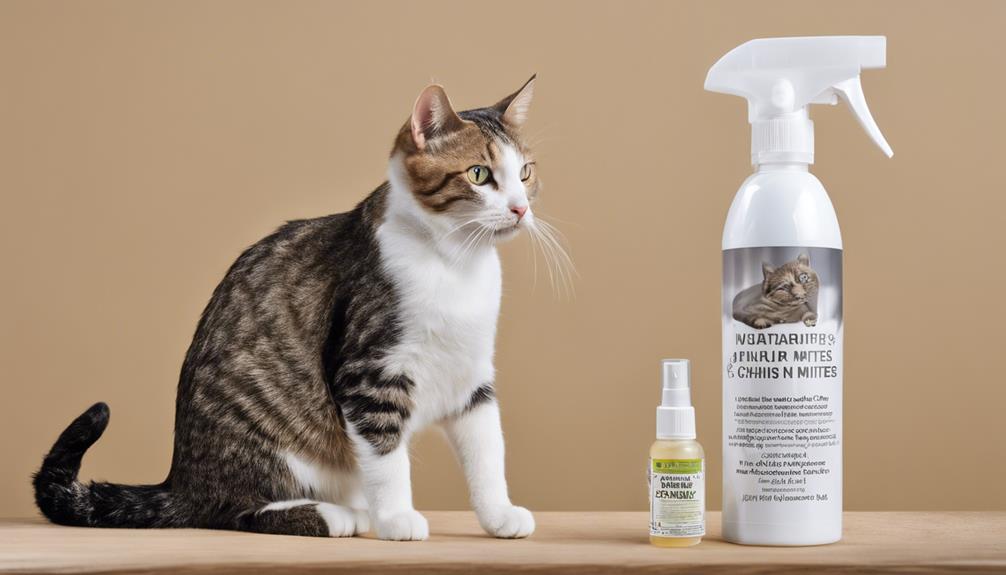
To safeguard against cat chin mites, it's crucial to groom your feline companion regularly and watch for any signs of infestation.
Routine vet check-ups can help detect any issues early on and guarantee your cat's overall health.
Grooming for Prevention
By maintaining a regular grooming routine with a cat-safe shampoo, cat owners can effectively prevent chin mites by ensuring the skin remains clean and free of debris. When grooming for prevention, consider the following tips:
- Use a fine-toothed comb or brush: Specifically designed for cats, these tools can help remove any potential mites or eggs from the chin area.
- Avoid harsh chemicals: Refrain from using products that may irritate the skin, potentially worsening mite infestations.
- Ensure a balanced diet: Supporting overall skin health and immune system can aid in preventing mite infestations.
Taking these steps can help keep your feline friend healthy and free from the discomfort of chin mites.
Regular Vet Check-Ups
When booking vet appointments, make sure to schedule timely check-ups to proactively address and prevent potential cat chin mite issues. Essential vet check-ups play an important role in monitoring and managing cat chin mites effectively.
During these visits, veterinarians can recommend preventive measures such as vaccinations and parasite control programs to reduce the risk of mite infestations in cats. Routine skin examinations conducted by vets can aid in early detection of cat chin mites before they become severe, ensuring prompt treatment and resolution.
Ensuring Feline Comfort

Ensuring the comfort of felines during the treatment of chin mites is essential for their well-being and recovery. When addressing feline comfort during chin mite treatment, consider the following:
- Soft Bedding: Providing a cozy and comfortable resting area can help your cat feel secure and relaxed during their treatment period.
- Gentle Handling: Approach your cat with care and gentleness to avoid causing additional stress or discomfort while administering treatments.
- Quiet Environment: Creating a calm and quiet space for your cat can help reduce anxiety and promote a sense of tranquility during their recovery process.
Frequently Asked Questions
How Do I Get Rid of Mites on My Cats Chin?
We use vet-prescribed topical medications like fipronil, selamectin, or ivermectin for cat chin mites. Regular cleaning helps prevent spread. Following vet advice on environmental treatment is vital. Monitoring for mites and seeking professional guidance are essential for effective treatment.
How Do You Treat Chin Dermatitis in Cats?
We treat chin dermatitis in cats by using topical medications like benzoyl peroxide or antibiotics to reduce inflammation. Regular cleaning with cat-safe products helps manage it. In severe cases, oral meds or corticosteroids may be needed under veterinary guidance.
Is There a Topical Treatment for Mites on Cats?
Absolutely, topical treatments like selamectin, fipronil, and imidacloprid/moxidectin are fantastic options to combat mites on cats effectively. These solutions, when applied directly to the skin, work wonders in eliminating those pesky mites and keeping our furry friends healthy and happy.
How Long Does It Take to Get Rid of Mites on Cats?
Getting rid of mites on cats can vary in duration depending on treatment and mite type. Consistent treatment adherence speeds up mite elimination. Regular vet follow-ups guarantee complete eradication. It's crucial to follow treatment plans to prevent reinfestation.
Can Chin Mites Cause My Cat’s Pupils to Stay Dilated?
Chin mites do not affect a cat’s pupils directly. If you’re concerned about dilated pupils, it’s important to consult a vet. Understanding cat pupils can help you notice abnormal changes and seek appropriate medical care for your pet.
Conclusion
To sum up, dealing with cat chin mites promptly is crucial for your feline friend's comfort and well-being.
By comprehending the symptoms, causes, and effective treatments, you can guarantee relief and prevent further issues.
Remember, keeping your cat's chin clean and monitoring for any signs of mites can secure a happy and healthy pet.
Stay informed, take action, and enjoy many chin scratch-free moments with your beloved furry companion.



